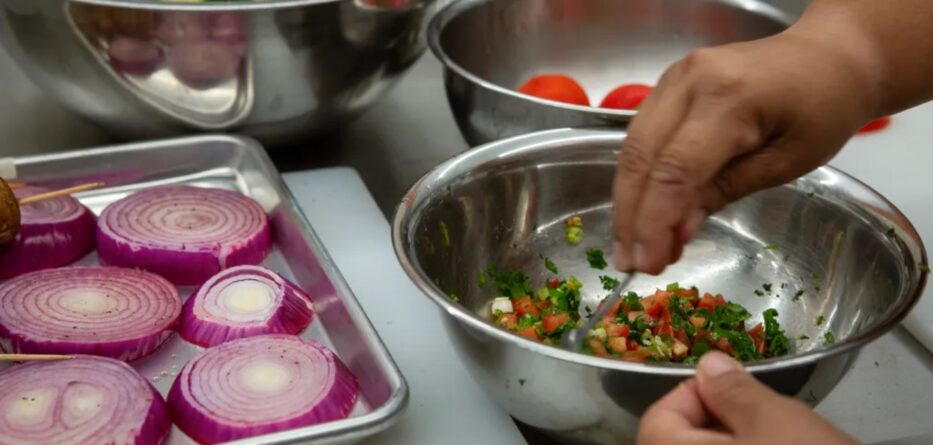Carolyn Jones
CalMatters
The hottest new restaurant in California might be your local elementary school.
Thanks to a surge of nearly $15 billion in state and federal funding, school districts are ditching the old standbys — frozen pizza and chicken nuggets — in favor of organic salads, free-range grilled chicken, vegan chana masala, chilaquiles and other treats. Districts are building new kitchens, hiring executive chefs, contracting directly with local organic farmers, and training their staffs to cook the finest cuisine. One district in San Luis Obispo County even bought a stone mill to grind its own wheat for bread and pasta.
The move to healthier, fresher school meals comes on the heels of California’s first-in-the-nation program providing free breakfast, lunch and snacks to nearly 6 million students in public schools, regardless of whether they qualify under federal income guidelines. The expansion of the meal program, combined with investments in school kitchens and training, have made public schools the largest restaurant system in the state, serving nearly 1 billion meals a year — more than McDonald’s, Starbucks and Subway combined.
“We now have the money and the green light to go all out. There’s no more excuses,” said Juan Cordon, food services director at Vacaville Unified, where students now enjoy offerings such as regeneratively raised pork sandwiches, Strauss Family Creamery organic yogurt and chipotle chilaquiles. “Everything is turbo charged. It’s like, let’s do it fast, let’s do it now, let’s do it right.”
A plethora of research shows the benefits of healthy school meals. A 2020 study in the journal Nutrients looked at 502 school meal programs and found that students who ate meals at school had better attendance, higher academic achievement and improved health overall.
The school meal expansion sprung from a handful of government investments during the pandemic, when the economy upended and schools closed, leaving thousands of low-income students and their families without steady access to food. The federal government expanded access to school meals for the first 27 months of the pandemic, and when that program expired, California stepped in with permanent funding for all students to receive free meals at school.
The state also created a program called Kitchen Infrastructure and Training Funds, which has given $750 million to schools to upgrade their kitchens, hire and train staff and make other improvements so they could serve high-quality meals made from scratch for all students. About 90% of districts have received a grant. Another state program, called Farm to School, has doled out nearly $100 million for schools to partner with local farms, plant school gardens and other projects to bolster locally sourced food in school lunchrooms.
“We now have the money and the green light to go all out. There’s no more excuses.”
JUAN CORDON, FOOD SERVICES DIRECTOR AT VACAVILLE UNIFIED
The switch to fresh, made-from-scratch meals has been popular with students.
Alysa Oliver, a sophomore at Aptos High in Pajaro Unified, said that school lunches used to be so bad she’d sometimes just eat an apple, suffering through the afternoon on an empty stomach.
“The food used to come in little plastic packages that you’d warm up, and it had this condensed, sweaty feeling,” Oliver said. “Now we have this high-quality food that’s better for you, and it tastes better.”
Enjoying a healthy meal enables her to pay closer attention in class, she said, and ultimately enjoy school more. Her favorite choices are Caesar salad, chicken wraps, berries and bananas.
Pajaro Valley Unified, in Santa Cruz County, is among the districts that’s on the forefront of the revolution in school meals. In addition to offering a daily selection of healthy entrees, the district has a partnership Esperanza Community Farms and Pajaro Valley High School in which students harvest produce themselves, bring it back to school and prepare it for their classmates. Local farmers visit classrooms to talk about agriculture, and students learn about career pathways in the farming industry. The program has been so popular that the district is expanding to another high school this year.
The challenges of ‘farm to school’
Although more schools statewide are embracing the farm-to-school model, there have been hiccups. Staffing is a major one. School food service workers typically earn less than $20 an hour, less than a fast food worker, which means districts often struggle to fill vacancies. A recent check of EdJoin, the state’s largest education job board, showed 851 openings for food service workers in California.
Another hassle for schools is paperwork. Even though the meals are free and available to all students, families still need to apply because schools need to track how many students qualify under the federal free-and-reduced-price lunch program. The federal government uses the numbers to reimburse schools for those children’s meals, and the state uses the numbers to determine funding formulas based on low-income student enrollment.
“The school lunch program is as complicated as the U.S. tax code. It is wild,” said Jennifer McNeil, a co-founder of LunchAssist, a firm that helps school districts navigate the bureaucracy. “There are a lot of requirements and mandates that affect what goes on that lunch tray.”
Another challenge is logistics. School kitchens typically don’t have the staff, time or room to clean and chop 500 butternut squashes, for example, so they need to send produce to a processing plant, which may be 50 miles away. Transporting the produce long distances can be expensive and inefficient, especially if it needs to be distributed to a dozen different school sites.
“I might need 30 cases of strawberries from Farmer X, and 20 cases of cucumbers from Farmer Y, and those farmers might have no way of getting their goods to different schools. It’s not easy,” said Jean Aitken, food services director at Pajaro Valley Unified. “We’re working on it, but right now we’re not set up to handle all the details.”
A need for more food hubs
Yousef Buzayan, farm-to-market senior manager at the Community Alliance with Family Farmers, an advocacy group based in Davis, said California needs more middlemen — known as food hubs — to purchase, process and distribute produce to schools. Currently, each district is forging its own arrangements, which is not practical in many parts of the state.
Food hubs could also arrange field trips, visits from farmers and other aspects of agricultural education, as well as help farmers get fair prices and a predictable, steady market for their produce. A few, such as the Yolo Food Hub, are already offering these services, but the state could use more, he said.
“Potentially, this could have a huge impact not just on students, but on farms in California generally, especially small farms,” Buzayan said. “But right now we need to think of a new business model focused just on schools.”
Getting students to love quinoa
Another thing LunchAssist helps with is the age-old challenge faced by parents everywhere: How do you get a 7-year-old to try new foods? All the innovative new programs will be for naught if kids toss their lunches in the trash, McNeil noted.
A few suggestions she offers to schools: Set up taste tests so students can vote for their favorites; educate students about nutrition, where food comes from and how it’s made; pair something new with an old favorite; and add Tajin seasoning, which can make anything taste good, she said.
Some districts are paying close attention to what students eat at home, and creating menus that reflect families’ diverse culinary traditions. The idea is to give students food they already enjoy while exposing them to new cuisines. Chefs at several districts vouched for the power of peer pressure: Kids are more likely to try something new if they see their friends eating it.
“The students like to be part of the conversation. By asking them what they like, where they’re from, it shows we’re paying attention and listening to them.”
JOSH GJERSAND, EXECUTIVE CHEF AT MOUNT DIABLO UNIFIED
At Mt. Diablo Unified in Contra Costa County, the district hired an executive chef, Josh Gjersand, who’d previously worked at fine dining restaurants in San Francisco and the East Bay. He chose to work in schools, he said, because of the regular hours, rewards of serving children and the funding available to be creative and ambitious.
One of his first tasks was to survey students about what they want to eat. They asked for halal meat, Latin American and Asian specialties and vegan options. So he came up with a menu featuring entrees like chana masala with chickpeas, organic rice, wheatberries and chutney; birria with locally processed, grass-fed beef; and fish filet tacos with slaw.
“The students like to be part of the conversation. By asking them what they like, where they’re from, it shows we’re paying attention and listening to them,” he said. “It’s amazing, the feedback we’ve been getting. It’s the best feeling.”
Humboldt County has a unique approach to serving “culturally relevant” school foods. Nearly 10% of students there are Native American, so the County Office of Education is offering meals — and curriculum — based on local native foods such as fish, berries and acorns.
“I started here 27 years ago and it’s exciting to see these changes, the positive impact on students and staff,” said Linda Prescott, the County Office of Education nutrition program director. “And we’re definitely seeing the economic impact on farmers. I think it’s making a difference in Humboldt.”
“I’m not really a cook. Before, we just defrosted stuff. This is all new and a little scary. But I want to learn.”
RENEE WILLIAMS, FOOD WORKER FOR 14 YEARS AT SAN LUIS COASTAL UNIFIED
The fine art of cooking was central to a training last week at the Culinary Institute of America in Napa, one of the top cooking schools in the country. About three dozen school cafeteria workers from two districts in San Luis Obispo County gathered for a two-day training — paid for with state grants — on how to roast a sirloin, make grilled salmon with orange-thyme butter, braise greens and make other delicacies.
Renee Williams, who’s been in food service for 14 years at San Luis Coastal Unified, said she was a little daunted by the whole scene: the special CIA aprons, the fancy gas stoves, the huge glinting knives.
“I’m not really a cook. Before, we just defrosted stuff,” Williams said. “This is all new and a little scary. But I want to learn.”
‘A circular economy’
First Partner Jennifer Siebel Newsom, who’s long advocated for improved school meals, checked in on the new chefs as they learned to julienne carrots and make the perfect roast potatoes.
She views the state’s investment in school nutrition as transformative for students, small farms and local economies. In five to 10 years she hopes to see food hubs well established throughout the state, and all schools participating.
“(My vision is that) we reach every public-school kid in California, and have influenced the regenerative agricultural movement in California in such a way that most farms are practicing climate-smart agriculture,” Siebel Newsom said. “The small- and medium-scale farmers will benefit because they’ll have guaranteed buyers, and local economies will blossom. It’s a circular economy.”
The next steps, she said, are tackling food waste by establishing composting systems, and teaching students how to plant and cook their own food.
“Talk about awesome summer school,” she said. “We all have to eat. It’s such a gift to know how to cook, and take something seasonal from the garden or the stream and turn it into something that you can then share with other people, break bread, have a conversation and connect and come together as a community.”






